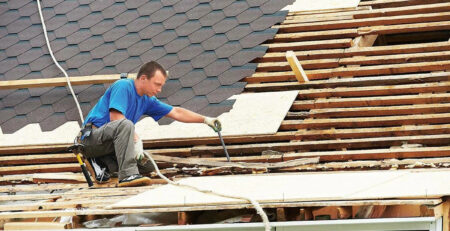Best Fire-Resistant Roofing Material for Homes
Choosing the right fire-resistant roofing material is essential to keeping your home safe from unexpected fires. The best roofing materials can slow the spread of flames, reduce damage, and give you critical time to respond. In this guide, we’ll cover the most fire-resistant options available to help you make the best decision for your home.
Why Fire-Resistance Matters
Fires can happen anywhere, whether from wildfires, nearby home fires, or even chimney sparks landing on your roof. A fire-resistant roof doesn’t make your home completely fireproof, but it drastically reduces the risk of ignition and gives you more time to react during emergencies.
Roofing materials are classified into fire-resistance ratings:
- Class A: The highest level of fire resistance
- Class B: Moderate fire resistance
- Class C: Minimal fire resistance
Choosing Class A materials is the safest option, especially in areas prone to fire hazards.

Fire-Resistant Roofing Materials to Consider
When it comes to fire-resistant roofing, there are multiple options to fit different styles and budgets. Here’s a closer look at the most popular ones:
Metal Roofing
[Fire-resistant roofing material: metal roofing]
Metal roofing is one of the most popular fire-resistant options. It’s non-combustible, lightweight, and reflective, which means it offers protection and energy efficiency at the same time.
Advantages:
- Doesn’t catch fire or ignite from embers
- Durable, lasting up to 50 years or more
- Can be recycled, making it eco-friendly
Drawbacks:
- High initial costs compared to asphalt shingles
- Louder during rain unless insulated
Metal roofing is an excellent choice for homeowners in fire-prone regions like the West Coast, where wildfires are more common.

Clay and Concrete Tiles
[Fire-resistant roofing material: clay tiles, concrete tiles]
Clay and concrete tiles are naturally fire-resistant and extremely durable. These heavy materials are often used in Mediterranean or Spanish-style homes, but they can be adapted for other styles too.
Advantages:
- Class A fire protection
- Long lifespan (50-100 years)
- Heavy, which provides added roof insulation
Drawbacks:
- Expensive to install
- Require proper structural support due to their weight
Tiles are ideal for homeowners looking to combine high fire-resistance with aesthetic appeal.

Asphalt Shingles with Class A Rating
[Fire-resistant roofing material: Class A asphalt shingles]
While standard asphalt shingles have minimal fire resistance, Class A asphalt shingles are treated with special fire-resistant chemicals to meet higher standards.
Advantages:
- Affordable and widely available
- Easy to install and replace
- Variety of colors and styles
Drawbacks:
- Less durable than other materials (average lifespan of 20-30 years)
- Requires maintenance
For budget-conscious homeowners, Class A asphalt shingles provide fire protection without breaking the bank.

Slate Roofing
[Fire-resistant roofing material: slate]
Slate is a natural stone that provides excellent fire resistance and adds a classic, elegant look to your home.
Advantages:
- Naturally non-combustible, Class A rating
- Long lifespan (over 100 years)
- High resistance to heat and moisture
Drawbacks:
- Expensive material and installation costs
- Heavy, requiring additional structural support
If you’re looking to invest in a timeless, top-quality roof, slate is an option worth considering.

Fiber Cement Roofing
[Fire-resistant roofing material: fiber cement]
Fiber cement roofing combines cement, sand, and cellulose fibers to create a sturdy, fire-resistant material.
Advantages:
- Class A fire protection
- Affordable compared to other durable materials like slate or clay
- Low maintenance
Drawbacks:
- Heavier than asphalt shingles
- Limited design options compared to tiles or slate
Fiber cement strikes a balance between affordability and fire resistance, making it suitable for many homeowners.
Factors to Consider When Choosing Fire-Resistant Roofing
Before choosing a fire-resistant roofing material, here are some key factors to consider:
1. Local Fire Codes
Many areas with high wildfire risks have specific building codes requiring fire-resistant roofs. Check your local codes to ensure the material you select meets the required standards.
2. Climate
While fire resistance is important, your roof also needs to handle your local climate. For example, metal roofing is great for both fire protection and reflecting heat in hot areas, while clay tiles are ideal for fire resistance and staying cool in sunny regions.
3. Budget
Certain fire-resistant options, like slate, come with high upfront costs. However, they last longer than cheaper options like asphalt shingles, so they may save money in the long run.
4. House Structure
Heavy materials like slate or tile require additional support from your home’s structure. Make sure your home can handle the weight of these materials before committing to them.
5. Insurance Incentives
Many insurance companies offer discounts for homes with Class A fire-resistant roofs. Installing a fire-resistant material could reduce your premiums, offering long-term savings.
How to Choose the Right Roofing Contractor
A fire-resistant roof is only as good as its installation. Choosing a professional roofing contractor ensures your roof is installed correctly and meets all local fire safety standards. Look for professionals with experience in fire-resistant roofing materials and positive reviews from previous customers in your area.
Protect Your Home with the Right Roof
Choosing the right fire-resistant roofing material is one of the best investments you can make for your home’s safety and value. Whether you prefer affordable asphalt shingles, durable metal roofing, or elegant slate, there’s an option to suit every budget and style.
If you’re ready to start planning your fire-resistant roof, consult with a roofing contractor to discuss your options. The right roof doesn’t just protect your house, it gives you peace of mind.











